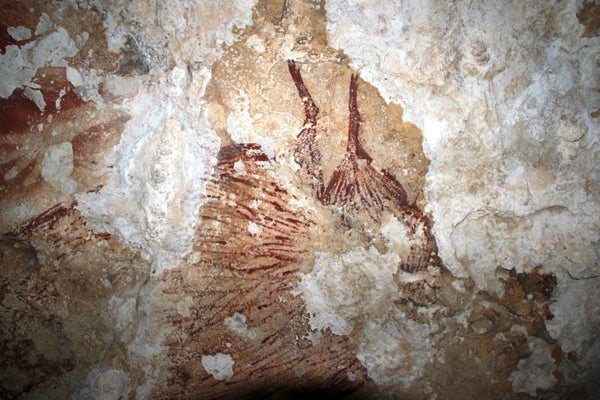Some of the oldest art in human history is disintegrating, scientists say. And climate change may be hastening its demise.
New research reports that ancient rock art in Indonesian caves is degrading over time, as bits of rock slowly flake away from the walls. It's a tremendous loss for human history — some of these paintings, which depict everything from animals to human figures to abstract symbols, date back about 40,000 years.
Salt crystals building up on the walls are a key part of the problem, the study suggests. These salt deposits seep into the cave walls, then proceed to expand and contract as temperatures rise and fall. This process causes the rock to slowly disintegrate.
On supporting science journalism
If you're enjoying this article, consider supporting our award-winning journalism by subscribing. By purchasing a subscription you are helping to ensure the future of impactful stories about the discoveries and ideas shaping our world today.
Changes in the weather may be helping the process along, scientists say.
Salt crystals may expand more readily when they're exposed to repeated shifts between wet, humid conditions and periods of prolonged drought. Indonesia is already a dynamic region to begin with, split between the rainy monsoon season and the annual dry season. But these kinds of shifts are expected to become more dramatic as the climate continues to warm.
In particular, the researchers say, climate change may spur more intense El Niño events in the future. These events can amplify the kinds of conditions that help the damaging salt crystals form.
Scientists are still debating the exact influence of climate change on El Niño, a natural climate cycle that drives shifting patterns of warming and cooling in the Pacific Ocean. But some studies do suggest that El Niño events may be more severe going forward.
The new study, led by Jillian Huntley at Australia's Griffith University, examined 11 ancient cave art sites in South Sulawesi, Indonesia. The researchers found evidence of salt formation at all 11 sites. At three of the sites, they found the types of crystals that most notoriously cause rocks to break apart.
It's a small sample; there are more than 300 known cave art sites scattered around the region. But the research suggests that salt crystals may indeed be part of the problem.
In recent years, archaeologists have reported that the art appears to be rapidly deteriorating — at some sites, experts have reported as much as an inch of art vanishing every couple of months.
Scientists have proposed multiple theories about what might be causing it. Along with climate change, they've suggested that pollution and other disturbances from nearby limestone mining operations might be degrading the fragile paintings.
It's probably all of the above, Huntley and her colleagues suggest. But they add that climate change is a growing threat, one that deserves more attention.
In fact, they argue, salt-related degradation is "the most pressing threat to rock art preservation in this region" aside from mining.
Reprinted from E&E News with permission from POLITICO, LLC. Copyright 2021. E&E News provides essential news for energy and environment professionals.
